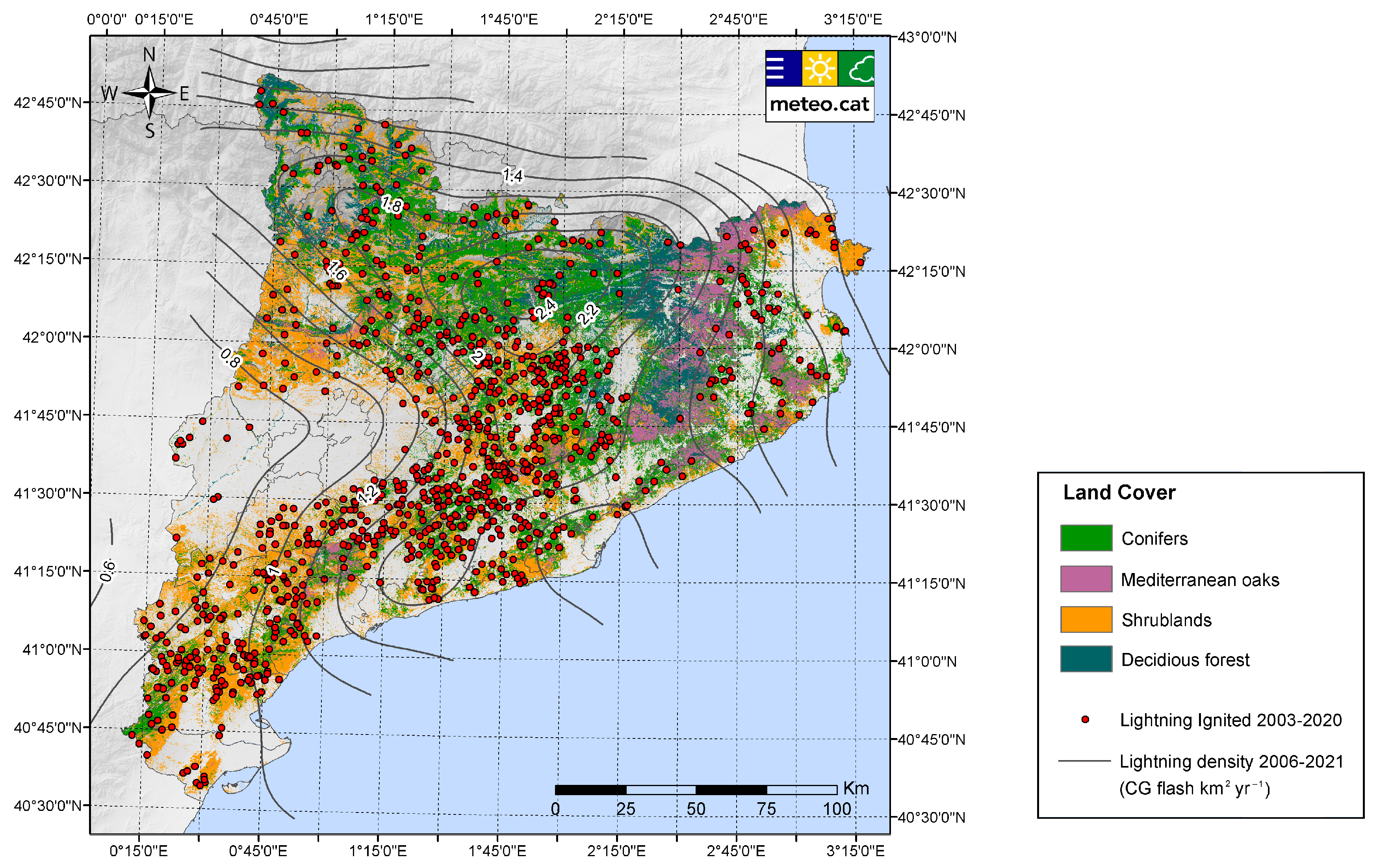ERA5 Reanalysis of Environments Conducive to Lightning-Ignited Wildfires in Catalonia
Abstract
1. Introduction
2. Materials and Methods
2.1. Subsection Study Domain
2.2. Datasets
2.3. Method
3. Results
3.1. Comparison between TS and LIW
3.1.1. Convective Available Potential Energy (CAPE)
3.1.2. High-Level Total Totals (HLTT)
3.1.3. Dew Point Depression (at 850 hPa)
3.1.4. Dry and Wet Days
3.1.5. Lifted Condensation Level (LCL)
3.1.6. Lapse Rate
3.1.7. Relative Humidity
3.2. Holdover Fires
3.2.1. Surface Dew Point Depression
3.2.2. Temperature and Relative Humidity
3.2.3. Fuel Moisture Index
4. Discussion
4.1. Forecasting LIWs
4.2. Holdover Fires
4.3. Assumptions and Uncertainties
4.4. Future Work
5. Conclusions
Supplementary Materials
Author Contributions
Funding
Institutional Review Board Statement
Informed Consent Statement
Data Availability Statement
Acknowledgments
Conflicts of Interest
References
- San-Miguel-Ayanz, J.; Moreno, J.M.; Camia, A. Analysis of large fires in European Mediterranean landscapes: Lessons learned and perspectives. For. Ecol. Manag. 2013, 294, 11–22. [Google Scholar] [CrossRef]
- Ganteaume, A.; Camia, A.; Jappiot, M.; San-Miguel-Ayanz, J.; Long-Fournel, M.; Lampin, C. A review of the main driving factors of forest fire ignition over Europe. Environ. Manag. 2013, 51, 651–662. [Google Scholar] [CrossRef] [PubMed]
- Camia, A.; Durrant, H.T.; San-Miguel-Ayanz, J. Harmonized Classification Scheme of Fire Causes in the EU Adopted for the European Fire Database of EFFIS; JRC 80682; Institute for Environment and Sustainability, Joint Research Centre, European Commission: Brussels, Belgium, 2013. [Google Scholar]
- Pugnet, L.; Lourenço, L.; Rocha, J. L’ignition des feux de forêt par l’action de la foudre au Portugal de 1996 à 2008. Territorium. Rev. Port. Riscos Prevenção E Segurança 2010, 17, 57–70. [Google Scholar]
- Russo, A.; Ramos, A.M.; Benali, A.; Trigo, R.M. Forest fires caused by lightning activity in Portugal. In Proceedings of the EGU Conference Abstracts, EGU General Assembly, Vienna, Austria, 8–13 April 2018; p. 17613. [Google Scholar]
- Fernandes, P.M.; Santos, J.A.; Castedo-Dorado, F.; Almeida, R. Fire from the Sky in the Anthropocene. Fire 2021, 4, 13. [Google Scholar] [CrossRef]
- Nieto, H.; Aguado, I.; García, M.; Chuvieco, E. Lightning-caused fires in Central Spain: Development of a probability model of occurrence for two Spanish regions. Agric. For. Meteorol. 2012, 162–163, 35–43. [Google Scholar] [CrossRef]
- Costafreda-Aumedes, S.; Cardil, A.; Molina, D.; Daniel, S.; Mavsar, R.; Vega-Garcia, C. Analysis of factors influencing deployment of fire suppression resources in Spain using artificial neural networks. iForest-Biogeosciences For. 2016, 9, 138–145. [Google Scholar] [CrossRef]
- Keeley, J.E.; Syphard, A.D. Large California wildfires: 2020 fires in historical context. Fire Ecol. 2021, 17, 22. [Google Scholar] [CrossRef]
- Latham, D.; Williams, E. Lightning and forest fires. In Forest Fires: Behavior and Ecological Effects; Johnson, E.A., Miyanishi, K., Eds.; Academic Press, Inc.: San Diego, CA, USA, 2001. [Google Scholar]
- Anderson, K. A model to predict lightning-caused fire occurrences. Int. J. Wildland Fire 2002, 11, 163–172. [Google Scholar] [CrossRef]
- Read, N.; Duff, T.J.; Taylor, P.G. A lightning-caused wildfire ignition forecasting model for operational use. Agric. For. Meteorol. 2018, 253–254, 233–246. [Google Scholar] [CrossRef]
- Podur, J.; Martell, D.L.; Csillag, F. Spatial patterns of lightning caused forest fires in Ontario, 1976–1998. Ecol. Modell. 2003, 164, 1–20. [Google Scholar] [CrossRef]
- Pineda, N.; Altube, P.; Alcasena, F.J.; Casellas, E.; San Segundo, H.; Montanyà, J. Characterising the holdover phase of lightning-ignited wildfires in Catalonia. Agric. For. Meteorol. 2022, 324, 109111. [Google Scholar] [CrossRef]
- Petersen, W.A.; Rutledge, S.A. On the relationship between cloud-to-ground lightning and convective rainfall. J. Geophys. Res. 1998, 103, 14025–14040. [Google Scholar] [CrossRef]
- Soula, S.; Chauzy, S. Some aspects of the correlation between lightning and rain activities in thunderstorms. Atmos. Res. 2001, 56, 355–373. [Google Scholar] [CrossRef]
- Liu, C.; Cecil, D.J.; Zipser, E.J.; Kronfeld, K.; Robertson, R. Relationships between lightning flash rates and radar reflectivity vertical structures in thunderstorms over the tropics and subtropics. J. Geophys. Res. 2012, 117, D06212. [Google Scholar] [CrossRef]
- Rorig, M.L.; Ferguson, S.A. Characteristics of lightning and wildland fire ignition in the Pacific Northwest. J. Appl. Meteor. 1999, 38, 1565–1575. [Google Scholar] [CrossRef]
- Hall, B.L. Fire ignitions related to radar reflectivity patterns in Arizona and New Mexico. Int. J. Wildland Fire 2008, 17, 317–327. [Google Scholar] [CrossRef]
- Pineda, N.; Rigo, T. The rainfall factor in lightning-ignited wildfires in Catalonia. Agric. For. Meteorol. 2017, 239, 249–263. [Google Scholar] [CrossRef]
- Soler, A.; Pineda, N.; San Segundo, H.; Bech, J.; Montanyà, J. Characterisation of thunderstorms that caused lightning-ignited wildfires. Int. J. Wildland Fire 2021, 30, 954–970. [Google Scholar] [CrossRef]
- Rorig, M.L.; Ferguson, S.A. The 2000 fire season: Lightning-caused fires. J. Appl. Meteor. 2002, 41, 786–791. [Google Scholar] [CrossRef]
- Rorig, M.L.; McKay, S.J.; Ferguson, S.A.; Werth, P. Model-generated predictions of dry thunderstorm potential. J. Appl. Meteorol. Climatol. 2007, 46, 605–614. [Google Scholar] [CrossRef]
- Dowdy, A.J.; Mills, G.A. Atmospheric and fuel moisture characteristics associated with lightning-attributed fires. J. Appl. Meteorol. Climatol. 2012, 51, 2025–2037. [Google Scholar] [CrossRef]
- Nauslar, N.J.; Kaplan, M.L.; Wallmann, J.; Brown, T.J. A Forecast Procedure for Dry Thunderstorms. J. Oper. Meteorol. 2013, 17, 200–214. [Google Scholar] [CrossRef]
- Pérez-Invernón, F.J.; Huntrieser, H.; Soler, S.; Gordillo-Vázquez, F.J.; Pineda, N.; Navarro-González, J.; Reglero, V.; Montanyà, J.; van der Velde, O.; Koutsias, N. Lightning-ignited wildfires and long-continuing-current lightning in the Mediterranean Basin: Preferential meteorological conditions. Atmos. Chem. Phys. Discuss. 2021, 21, 17529–17557. [Google Scholar] [CrossRef]
- Garcia-Ortega, E.; Trobajo, M.T.; Loópez, L.; Sánchez, J.L. Synoptic patterns associated with wildfires caused by lightning in Castile and Leon, Spain. Nat. Hazards Earth Syst. Sci. 2011, 11, 851–863. [Google Scholar] [CrossRef]
- Pineda, N.; Peña, J.C.; Soler, X.; Aran, M.; Pérez-Zanón, N. Synoptic weather patterns conducive to lightning-ignited wildfires in Catalonia. Adv. Sci. Res. 2022, 19, 39–49. [Google Scholar] [CrossRef]
- Skinner, W.R.; Flannigan, M.D.; Stocks, B.J.; Martell, D.L.; Wotton, B.M.; Todd, J.B.; Bosch, E.M. A 500 hPa synoptic wildland fire climatology for large Canadian forest fires, 1959–1996. Theor. Appl. Climatol. 2002, 71, 157–169. [Google Scholar] [CrossRef]
- van Wagtendonk, J.W.; Cayan, D.R. Temporal and Spatial Distribution of Lightning Strikes in California in Relation to Large-Scale Weather Patterns. Fire Ecol. 2008, 4, 34–56. [Google Scholar] [CrossRef]
- Wastl, C.; Schunk, C.; Lüpke, M.; Cocca, G.; Conedera, M.; Valese, E.; Menzel, A. Large-scale weather types, forest fire danger, and wildfire occurrence in the Alps. Agric. For. Meteorol. 2013, 168, 15–25. [Google Scholar] [CrossRef]
- Millan, M.; Estrela, M.; Badenas, C. Meteorological processes relevant to forest fire dynamics on the Spanish Mediterranean coast. J. Appl. Meteorol. 1998, 37, 83–100. [Google Scholar] [CrossRef]
- Pereira, M.G.; Trigo, R.M.; da Camara, C.C.; Pereira, J.M.C.; Leite, S.M. Synoptic patterns associated with large summer forest fires in Portugal. Agric. For. Meteorol. 2005, 129, 11–25. [Google Scholar] [CrossRef]
- Rasilla, D.F.; Garcia-Codron, J.C.; Carracedo, V.; Diego, C. Circulation patterns, wildfire risk and wildfire occurrence at continental Spain. Phys. Chem. Earth 2010, 35, 553–560. [Google Scholar] [CrossRef]
- Kassomenos, P. Synoptic circulation control on wildfire occurrence. Phys. Chem. Earth 2010, 35, 544–552. [Google Scholar] [CrossRef]
- Coughlan, R.; Di Giuseppe, F.; Vitolo, C.; Barnard, C.; Lopez, P.; Drusch, M. Using machine learning to predict fire-ignition occurrences from lightning forecasts. Meteorol. Appl. 2021, 28, e1973. [Google Scholar] [CrossRef]
- Hersbach, H.; Bell, B.; Berrisford, P.; Hirahara, S.; Horányi, A.; Muñoz-Sabater, J.; Nicolas, J.; Peubey, C.; Radu, R.; Schepers, D.; et al. The ERA5 global reanalysis. Q. J. R. Meteorol. Soc. 2020, 146, 1999–2049. [Google Scholar] [CrossRef]
- Albentosa, L.M. Bibliografía de Climatología y Meteorología de Cataluña. Rev. Geogr. Dep. Geogr. i AGR 1980, 127–159. [Google Scholar]
- Martín-Vide, J.; Sanchez-Lorenzo, A.; Lopez-Bustins, J.A.; Cordobilla, M.J.; Garcia-Manuel, A.; Raso, J.M. Torrential rainfall in northeast of the Iberian Peninsula: Synoptic patterns and WeMO influence. Adv. Sci. Res. 2008, 2, 99–105. [Google Scholar] [CrossRef]
- Barrera-Escoda, A.; Llasat, M.C. Evolving flood patterns in a Mediterranean region and climatic factors–the case of Catalonia. Hydrol. Earth. Syst. Sc. 2015, 19, 465–483. [Google Scholar] [CrossRef]
- Campins, J.; Jansá, A.; Benech, B.; Koffi, E.; Bessemoulin, P. PYREX Observation and Model Diagnosis of the Tramontane Wind. Meteorol. Atmos. Phys. 1995, 56, 209–228. [Google Scholar] [CrossRef]
- Pascual, R.; Callado, A. Meso-analysis of recurrent convergence zones in the north-eastern Iberian Peninsula. In Proceedings of the Second European Conference on Radar Meteorology (ERAD), Delft, The Netherlands, 18–22 November 2002. [Google Scholar]
- Pineda, N.; Soler, X.; Vilaclara, E. Aproximació a la Climatologia de Llamps a Catalunya, Nota D’estudi del Servei Meteorològic de Catalunya; Generalitat de Catalunya B-7024-2011; Generalitat de Catalunya: Barcelona, Spain, 2011; Volume 73, ISBN 9788439387282. (In Catalan) [Google Scholar]
- Anderson, G.; Klugmann, D.A. European lightning density analysis using 5 years of ATDnet data. Nat. Hazards Earth Syst. 2014, 14, 815–829. [Google Scholar] [CrossRef]
- Poelman, D.R.; Schulz, W.; Diendorfer, G.; Bernardi, M. The European lightning location system EUCLID–part 2: Observations. Nat. Hazards Earth Syst. Sci. 2016, 16, 607–616. [Google Scholar] [CrossRef]
- Aran, M.; Peña, J.C.; Pineda, N.; Soler, X.; Perez-Zanon, N. Ten-year lightning patterns in Catalonia using Principal Component Analysis. In Proceedings of the 8th European Conference on Severe Storms—ECSS 2015, Wiener, Neustadt, Austria, 14–18 September 2015. [Google Scholar]
- Servei de Prevenció d’Incendis Forestals, Departament d’Agricultura, Ramaderia, Pesca i Alimentació, Generalitat de Catalunya (GENCAT). Base de Dades D’incendis Forestals. Available online: http://sac.gencat.cat/ (accessed on 15 March 2023).
- Centre de Recerca Ecològica Aplicada i Forestal (CREAF) Land Cover Map of Catalonia (v.2017). Available online: https://www.creaf.uab.es/mcsc/esp/index.htm (accessed on 15 March 2023).
- Servei Meteorològic de Catalunya (SMC). Anuari de Dades Meteorològiques. Available online: https://www.meteo.cat/wpweb/climatologia/serveis-i-dades-climatiques/anuaris-de-dades-meteorologiques/xarxa-de-deteccio-de-descarregues-electriques/ (accessed on 14 May 2022).
- Alcasena, F.J.; Ager, A.A.; Bailey, J.D.; Pineda, N.; Vega-García, C. Towards a comprehensive wildfire management strategy for Mediterranean areas: Framework development and implementation in Catalonia, Spain. J. Environ. Manag. 2019, 231, 303–320. [Google Scholar] [CrossRef]
- Pineda, N.; Montanyà, J. Lightning detection Spain: The particular case of Catalonia. In Lightning: Principles Instruments and Applications; Betz, H.-D., Schumann, U., Laroche, P., Eds.; Springer: Dordrecht, The Netherlands, 2009; pp. 161–185. [Google Scholar]
- Copernicus Climate Change Service (C3S). ERA5: Fifth Generation of ECMWF Atmospheric Reanalyses of the Global Climate. Copernicus Climate Change Service Climate Data Store (CDS). Available online: https://cds.climate.copernicus.eu/ (accessed on 15 March 2023).
- Rodríguez, O.; Bech, J. Tornadic environments in the Iberian Peninsula and the Balearic Islands based on ERA5 reanalysis. Int. J. Climatol. 2021, 41, E1959–E1979. [Google Scholar] [CrossRef]
- Rigo, T.; Rodríguez, O.; Bech, J.; Farnell, C. An observational analysis of two companion supercell storms over complex terrain. Atmos. Res. 2022, 272, 106149. [Google Scholar] [CrossRef]
- Larjavaara, M.; Pennanen; Tuomi, T. Lightning that ignites forest fires in Finland. Agric. For. Meteorol. 2005, 132, 171–180. [Google Scholar] [CrossRef]
- Flannigan, M.; Wotton, B. Lightning-ignited forest fires in northwestern Ontario. Can. J. For. Res. 1991, 21, 277–287. [Google Scholar] [CrossRef]
- Martell, D.L.; Sun, H. The impact of fire suppression, vegetation, and weather on the area burned by lightning-caused forest fires in Ontario. Can. J. For. Res. 2008, 38, 1547–1563. [Google Scholar] [CrossRef]
- Milne, R.M. A Modified Total Totals Index for Thunderstorm Potential over the Intermountain West. WR Tech. Attach. 2004, 4, 4–15. [Google Scholar]
- Sharples, J.; McRae, R.; Weber, R.; Gill, A. A simple index for assessing fire danger rating. Environ. Modell Softw. 2009, 24, 764–774. [Google Scholar] [CrossRef]
- Bates, B.C.; Dowdy, A.J.; Chandler, R.E. Classification of Australian thunderstorms using multivariate analyses of large-scale atmospheric variables. J. Appl. Meteorol. Climatol. 2017, 56, 1921–1937. [Google Scholar] [CrossRef]
- Kalashnikov, D.A.; Abatzoglou, J.T.; Nauslar, N.J.; Swain, D.L.; Touma, D.; Singh, D. Meteorological and geographical factors associated with dry lightning in central and northern California. Environ. Res. Clim. 2022, 1, 025001. [Google Scholar] [CrossRef]
- ThunderR. ERA5 Sigma Levels Browser Europe. 2022. Available online: http://www.rawinsonde.com/ERA5_Europe/ (accessed on 15 July 2022).
- Wallmann, J. A procedure for forecasting dry thunderstorms in the Great Basin using the dynamic tropopause and alternate tools for assessing instability. NOAA/NWS WR Tech. Attach 2004, 4–8. [Google Scholar]
- Wallmann, J.; Milne, R.; Smallcomb, C.; Mehle, M. Using the 21 June 2008 California lightning outbreak to improve dry lightning forecast procedures. Weather Forecast. 2010, 25, 1447–1462. [Google Scholar] [CrossRef]
- Welch, B.L. The generalization of Student’s problem when several different population variances are involved. Biometrika 1947, 34, 28–35. [Google Scholar] [CrossRef] [PubMed]
- Moder, K. How to keep the Type I Error Rate in ANOVA if Variances are Heteroscedastic. Austrian J. Stat. 2007, 36, 179–188. [Google Scholar] [CrossRef]
- Johns, R.H.; Doswell, C.A., III. Severe local storms forecasting. Weather Forecast. 1992, 8, 559–569. [Google Scholar] [CrossRef]
- Doswell, C.A., III; Schultz, D.M. On the use of indices and parameters in forecasting severe storms. Electron. J. Sev. Storms Meteor. 2006, 1, 1–14. [Google Scholar] [CrossRef]
- Westermayer, A.; Groenemeijer, P.; Pistotnik, G.; Sausen, R.; Faust, E. Identification of favorable environments for thunderstorms in reanalysis data. Meteorol. Z. 2017, 26, 59–70. [Google Scholar] [CrossRef]
- Houston, A.L.; Niyogi, D. The sensitivity of convective initiation to the lapse rate of the active cloud-bearing layer. Mon. Wea. Rev. 2007, 135, 3013–3032. [Google Scholar] [CrossRef]
- Dudhia, J. Back to basics: Thunderstorms: Part 1. Weather 1996, 51, 371–376. [Google Scholar] [CrossRef]
- Nauslar, N.J. A Forecast Procedure for Dry Thunderstorms. Master’s Thesis, University of Nevada, Reno, NV, USA, 2010; p. 1484044. [Google Scholar]
- Dowdy, A.J. Climatology of thunderstorms, convective rainfall and dry lightning environments in Australia. Clim. Dyn. 2020, 54, 3041–3052. [Google Scholar] [CrossRef]
- Nag, A.; Murphy, M.J.; Schulz, W.; Cummins, K.L. Lightning locating systems: Insights on characteristics and validation techniques. Earth Space Sci. 2015, 2, 65–93. [Google Scholar] [CrossRef]
- March, V.; Montanyà, J.; Pineda, N. Negative Lightning Current Parameters and Detection Efficiency for Two Operational LLS in Catalonia (NE Spain). In Proceedings of the International Conference on Lightning Protection (ICLP), Shanghai, China, 11–18 October 2014. [Google Scholar]
- Schultz, C.J.; Nauslar, N.J.; Wachter, J.B.; Hain, C.R.; Bell, J.R. Spatial, Temporal and Electrical Characteristics of Lightning in Reported Lightning-Initiated Wildfire Events. Fire 2019, 2, 18. [Google Scholar] [CrossRef]
- Moris, J.V.; Conedera, M.; Nisi, L.; Bernardi, M.; Cesti, G.; Pezzatti, G.B. Lightning-caused fires in the Alps: Identifying the igniting strokes. Agric. For. Meteorol. 2020, 290, 107990. [Google Scholar] [CrossRef]
- MacNamara, B.R.; Schultz, C.J.; Fuelberg, H.E. Flash characteristics and precipitation metrics of Western US lightning-initiated wildfires from 2017. Fire 2020, 3, 5. [Google Scholar] [CrossRef]
- Taszarek, M.; Pilguj, N.; Allen, J.T.; Gensini, V.; Brooks, H.E.; Szuster, P. Comparison of Convective Parameters Derived from ERA5 and MERRA-2 with Rawinsonde Data over Europe and North America. J. Clim. 2021, 34, 3211–3237. [Google Scholar]
- Rodríguez-Pérez, J.R.; Ordóñez, C.; Roca-Pardiñas, J.; Vecín-Arias, D.; Castedo-Dorado, F. Evaluating lightning-caused fire occurrence using spatial generalized additive models: A case study in central Spain. Risk Anal. 2020, 40, 1418–1437. [Google Scholar] [CrossRef]
- Rodrigues, M.; Jiménez-Ruano, A.; Gelabert, P.J.; de Dios, V.R.; Torres, L.; Ribalaygua, J.; Vega-García, C. Modelling the daily probability of lightning-caused ignition in the Iberian Peninsula. Int. J. Wildland Fire 2023, 32, 351–362. [Google Scholar] [CrossRef]
- McCann, D.W. 1994: WINDEX—A New Index for Forecasting Microburst Potential. Weather Forecast. 1994, 9, 532–541. [Google Scholar] [CrossRef]
- George, J. Weather Forecasting for Aeronautics; Academic Press: London, UK, 1960; p. 673. [Google Scholar]
- Miller, R.C. Notes on Analysis and Severe-Storm Forecasting Procedures of the Air Force Global Weather Central; AWS Tech. Rpt. 200(rev); Air Weather Service, Scott AFB, IL: Kansas City, MO, USA, 1972. [Google Scholar]
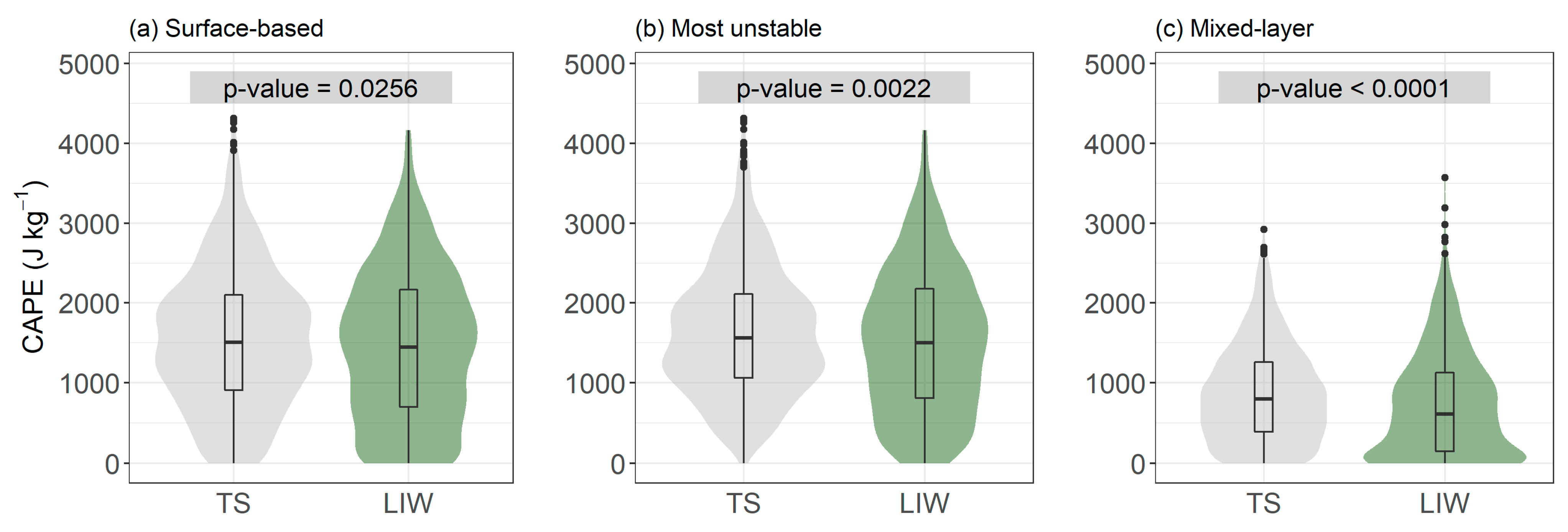

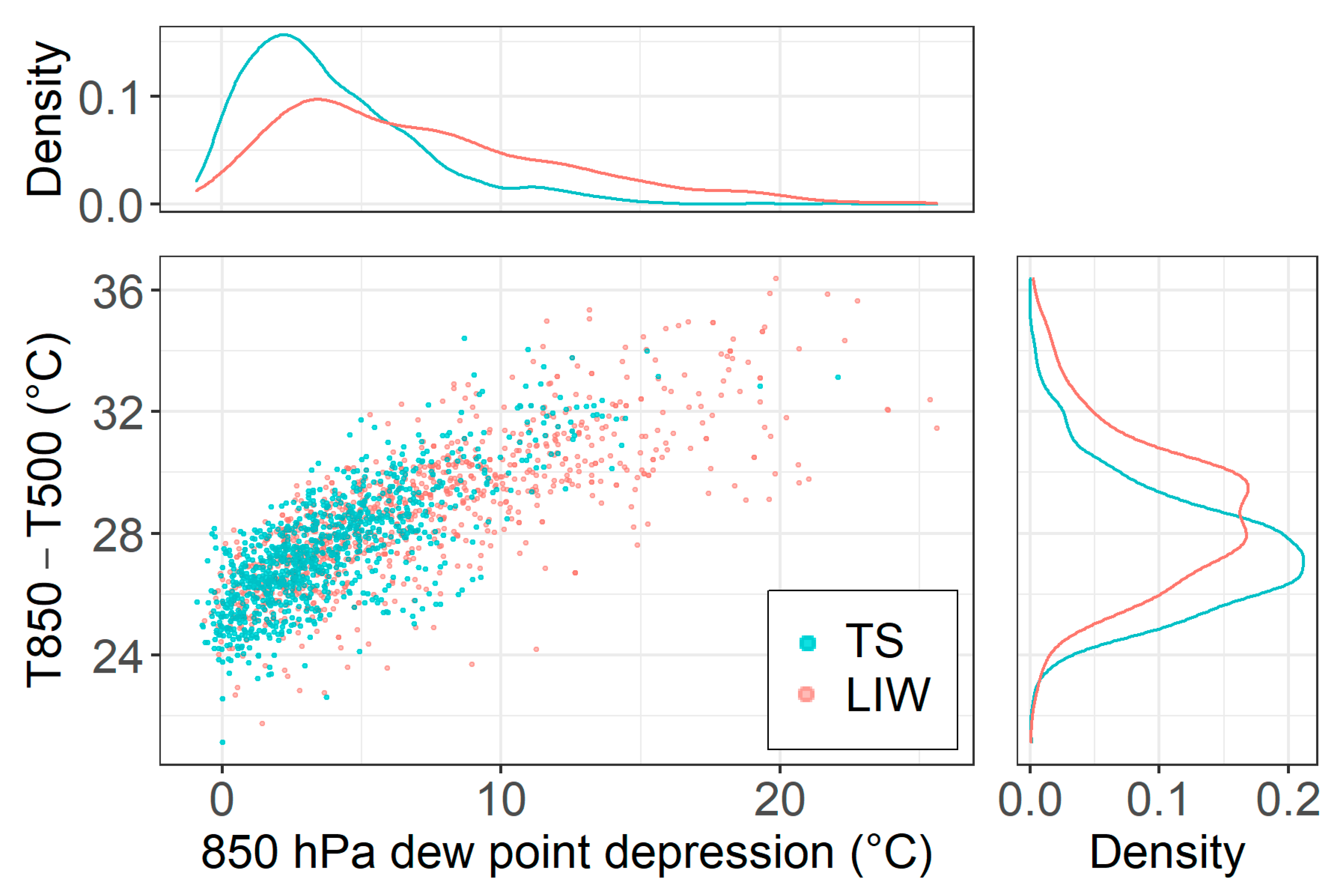
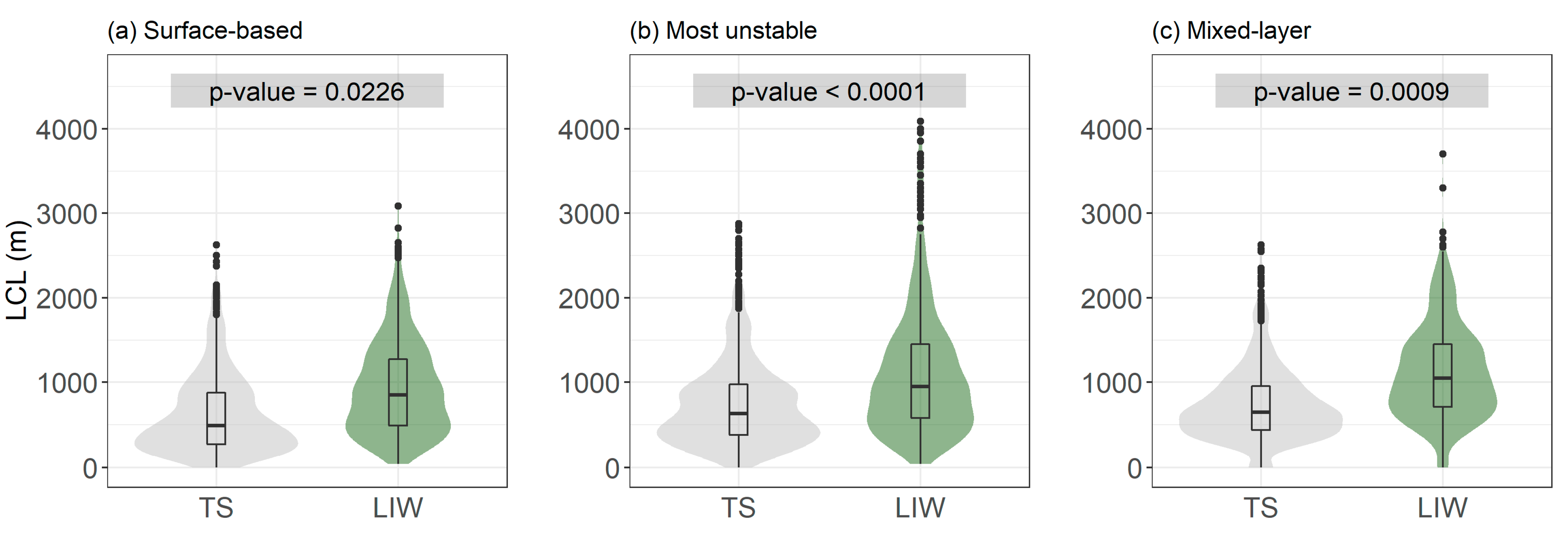
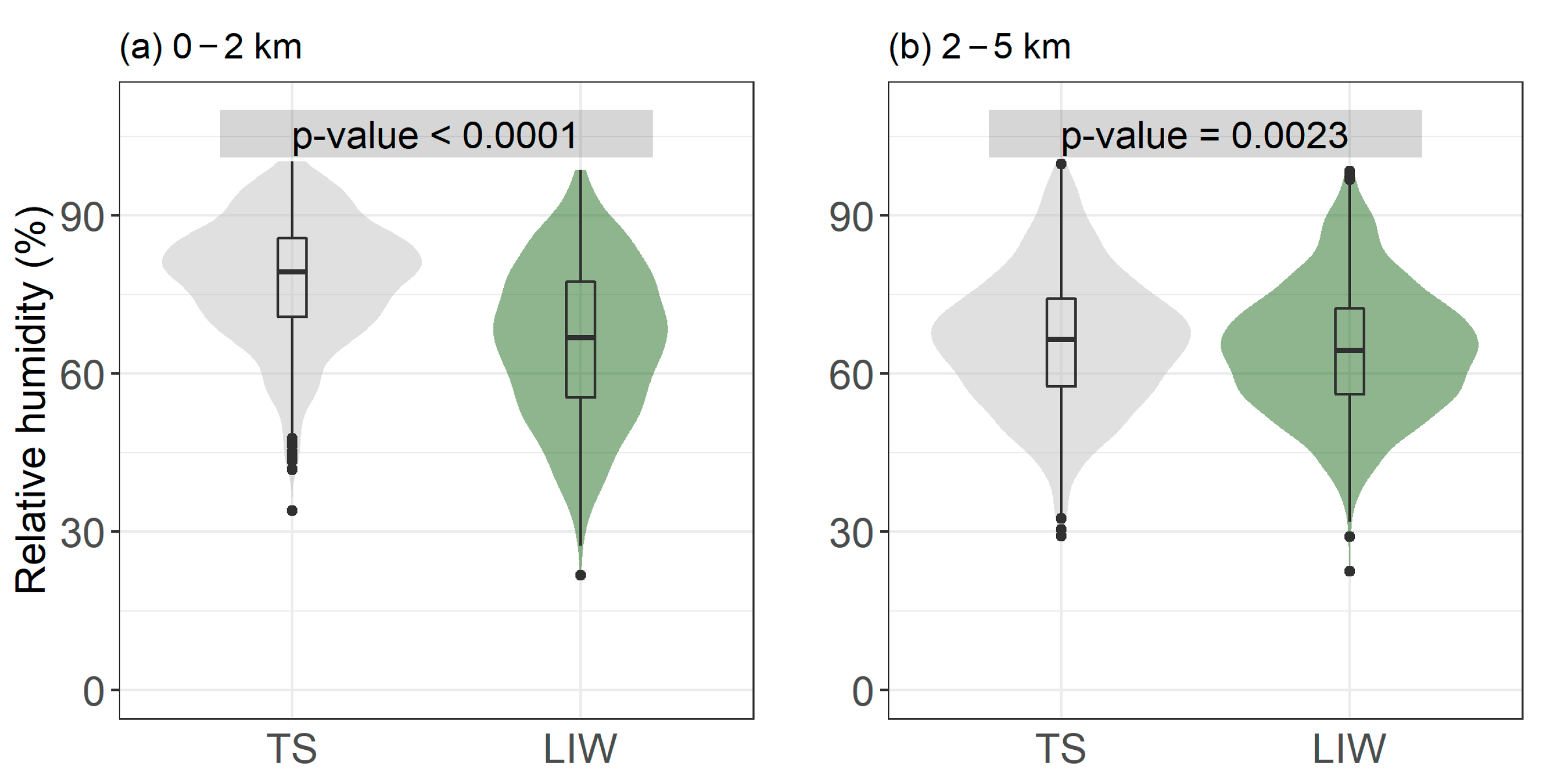
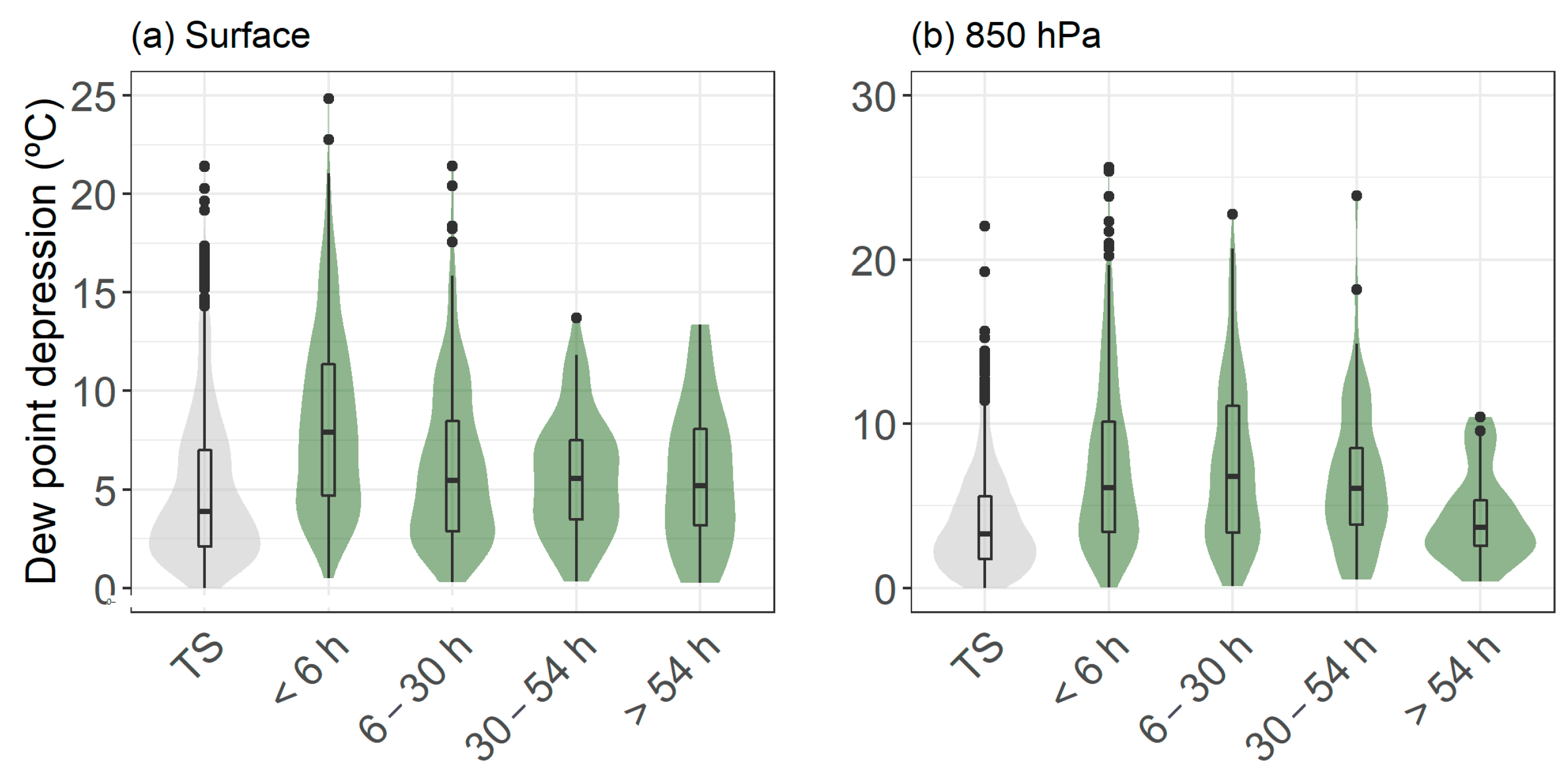
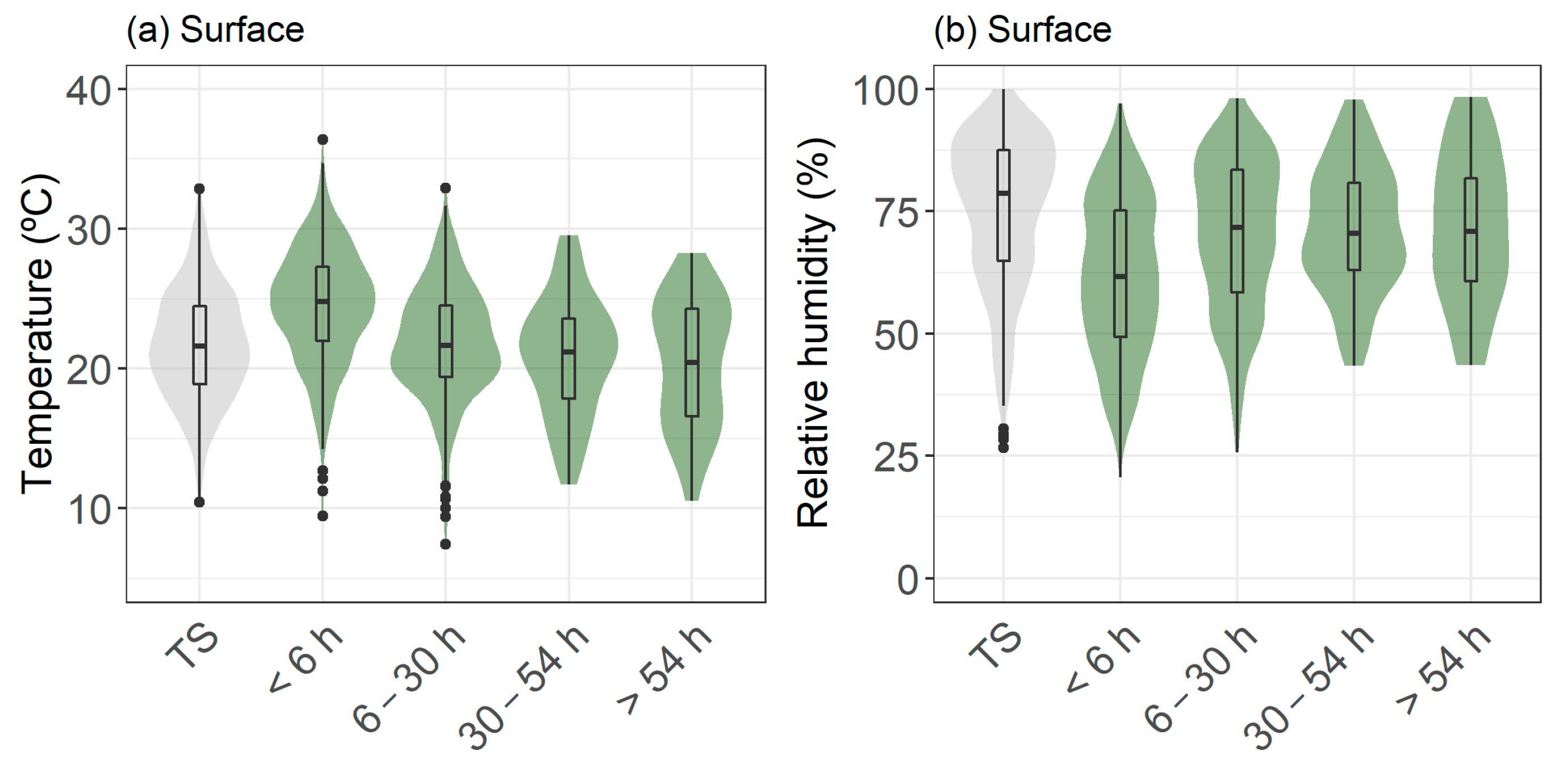
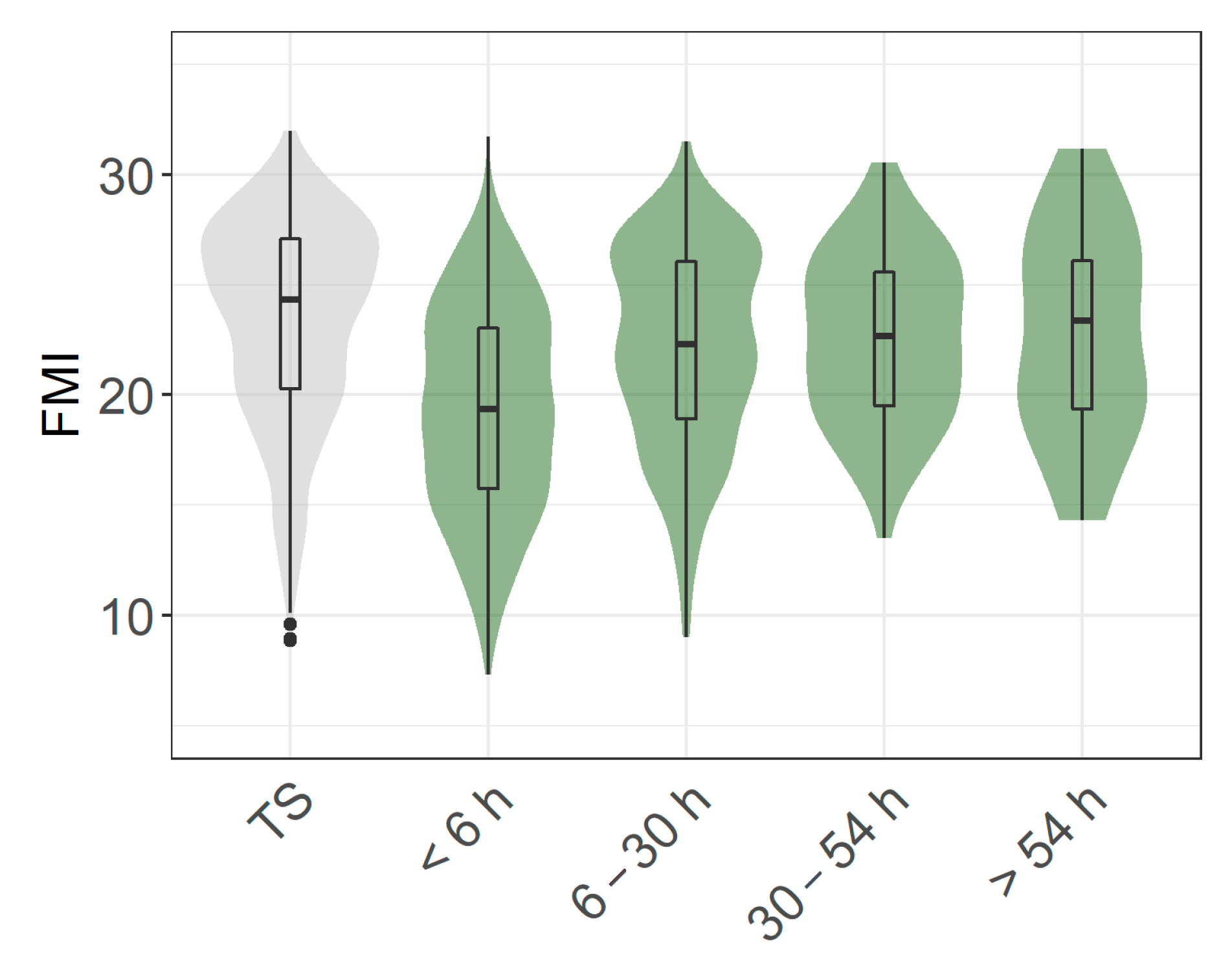
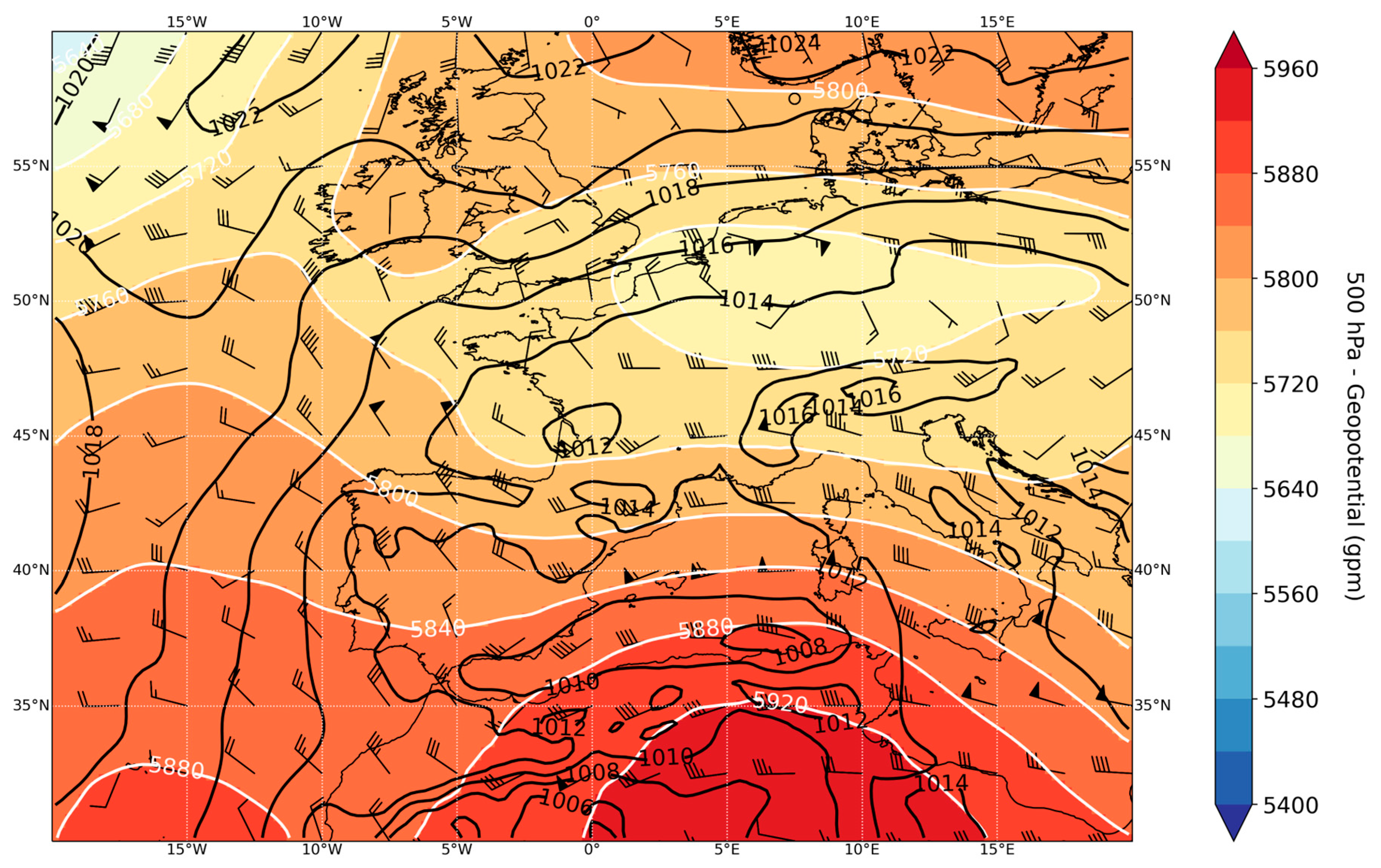
| Parameter | Units | Comments |
|---|---|---|
| Convective Available Potential Energy (CAPE) | J kg−1 | Using SB, ML, and MU parcels |
| Lapse rate (LR) | °C km−1 | Between 700 and 500 hPa |
| Temperature (T) | °C | At 2 m |
| Temperature difference (T850–T500) | °C | Temperature at 850 hPa and 500 hPa |
| Dew point depression (DPD) | °C | At 850 hPa and 2 m |
| Relative humidity (RH) | % | At 2 m and between 0 and 2 km, and 2 and 5 km |
| Lifting condensation level (LCL) | m | Using SB, ML, and MU parcels |
| High-level total totals (HLTT) | °C | According to Milne [58] |
| Fuel Moisture Index (FMI) | dimensionless | According to Sharples et al. [59] |
Disclaimer/Publisher’s Note: The statements, opinions and data contained in all publications are solely those of the individual author(s) and contributor(s) and not of MDPI and/or the editor(s). MDPI and/or the editor(s) disclaim responsibility for any injury to people or property resulting from any ideas, methods, instructions or products referred to in the content. |
© 2023 by the authors. Licensee MDPI, Basel, Switzerland. This article is an open access article distributed under the terms and conditions of the Creative Commons Attribution (CC BY) license (https://creativecommons.org/licenses/by/4.0/).
Share and Cite
Pineda, N.; Rodríguez, O. ERA5 Reanalysis of Environments Conducive to Lightning-Ignited Wildfires in Catalonia. Atmosphere 2023, 14, 936. https://doi.org/10.3390/atmos14060936
Pineda N, Rodríguez O. ERA5 Reanalysis of Environments Conducive to Lightning-Ignited Wildfires in Catalonia. Atmosphere. 2023; 14(6):936. https://doi.org/10.3390/atmos14060936
Chicago/Turabian StylePineda, Nicolau, and Oriol Rodríguez. 2023. "ERA5 Reanalysis of Environments Conducive to Lightning-Ignited Wildfires in Catalonia" Atmosphere 14, no. 6: 936. https://doi.org/10.3390/atmos14060936
APA StylePineda, N., & Rodríguez, O. (2023). ERA5 Reanalysis of Environments Conducive to Lightning-Ignited Wildfires in Catalonia. Atmosphere, 14(6), 936. https://doi.org/10.3390/atmos14060936




